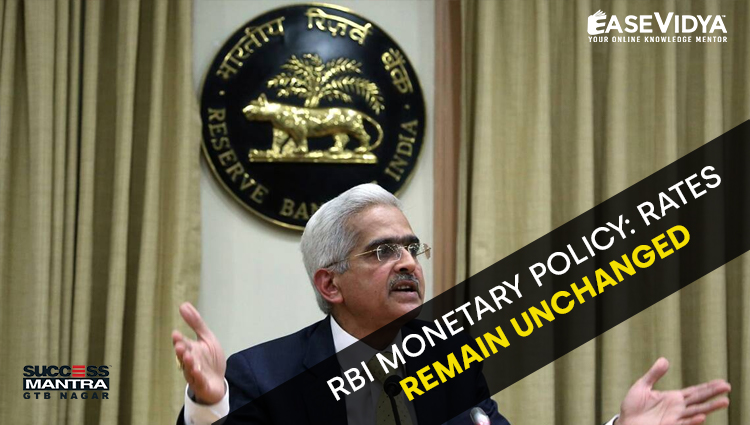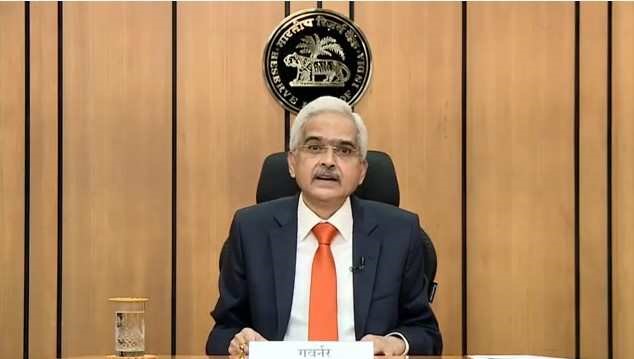
RBI MONETARY POLICY
RBI MONETARY POLICY: RATES REMAIN UNCHANGED

The Reserve Bank of India (RBI) has released the Monetary Policy Report for the month of April 2021.
- Unchanged Policy Rates:
- Repo Rate - 4%
- Reverse Repo Rate - 3.35%.
- Marginal Standing Facility (MSF) - 4.25%.
- Bank Rate- 4.25%.
- GDP Projection: Real Gross Domestic Product (GDP) growth for 2021-22 has been retained at 10.5%.
Inflation: RBI has revised the projection for Consumer Price Index (CPI) inflation to:
- 0% in Quarter 4 of 2020-21.
- 2% in Quarter 1 of 2021-22.
- 2% in Quarter 2 of 2021-22.
- 4% in Quarter 3 of 2021-22.
- 1% in Quarter 4 of 2021-22.
Accommodative Stance: The RBI decided to continue with the accommodative stance as long as necessary to sustain growth on a durable basis and continue to mitigate the impact of Covid-19 on the economy, while ensuring that inflation remains within the target going forward. An accommodative stance means a central bank will cut rates to inject money into the financial system whenever needed.
Support to Financial Institutions: RBI would extend fresh support of Rs. 50,000 crore to the All India Financial Institutions for new lending in Financial Year (FY) 2021-22. National Bank for Agriculture and Rural Development (NABARD) will be provided a Special Liquidity Facility (SLF) of Rs. 25,000 crore for one year to support agriculture and allied activities, the rural non-farm sector and Non-Banking Financial Companies (NBFCs) - Micro-Finance Institutions (MFIs). An SLF of Rs. 10,000 crore will be extended to the National Housing Bank for one year to support the housing sector. Small Industries Development Bank of India (SIDBI) will be provided Rs.15,000 crore under this facility for up to one year for funding of Micro, Small and Medium enterprises (MSMEs). All three facilities will be available at the prevailing policy repo rate.
Review Committee for ARC’s: Signalling the importance of Asset Reconstruction Companies (ARCs) to deal with bad loans, the RBI would constitute a committee to undertake a comprehensive review of the working of ARCs in the financial sector ecosystem. The committee will recommend suitable measures for enabling such entities to meet the growing requirements of the financial sector.
Extension of Priority Sector Lending: A six-month extension to September 30,2021 for Priority Sector Lending (PSL) classification for lending by banks to NBFCs for ‘on-lending’ to sectors that contribute significantly to the economy in terms of export and employment — has been approved. On-lending means to lend (borrowed money) to a third party. This would provide an impetus to NBFCs providing credit at the bottom of the pyramid.
Government Securities Acquisition Programme (G-SAP) 1.0: The RBI, for the year 2021-22, has decided to put in place a secondary market Government Security (G-sec) Acquisition Programme or G-SAP 1.0. It is part of RBIs Open Market Operations. Under the programme, the RBI will commit upfront to a specific amount of Open Market Purchases of government securities. The first purchase of government securities for an aggregate amount of Rs. 25,000 crore under G-SAP 1.0 will be conducted on 15th April, 2021.
Objective: To avoid volatility in the G-sec market in view of its central role in the pricing of other financial market instruments across the term structure and issuers, both in the public and private sectors
Significance: It will provide certainty to the bond market participants with regard to RBI’s commitment of support to the bond market in FY22. The announcement of this structured programme will help reduce the difference between the repo rate and the 10-year government bond yield. That, in turn, will help to reduce the aggregate cost of borrowing for the Centre and states in FY 2021-22. It will enable a stable and orderly evolution of the yield curve amidst comfortable liquidity conditions. A yield curve is a line that plots yields (interest rates) of bonds having equal credit quality but differing maturity dates. The slope of the yield curve gives an idea of future interest rate changes and economic activity.
RELATED KEY TERMINOLOGIES

Repo and Reverse Repo Rate: Repo rate is the rate at which the central bank of a country (Reserve Bank of India in case of India) lends money to commercial banks in the event of any shortfall of funds. Here, the central bank purchases the security. Reverse repo rate is the rate at which the RBI borrows money from commercial banks within the country.
Bank Rate: It is the rate charged by the RBI for lending funds to commercial banks.
Marginal Standing Facility (MSF): MSF is a window for scheduled banks to borrow overnight from the RBI in an emergency situation when interbank liquidity dries up completely. Under interbank lending, banks lend funds to one another for a specified term.
Open Market Operations: These are market operations conducted by RBI by way of sale/purchase of government securities to/from the market with an objective to adjust the rupee liquidity conditions in the market on a durable basis. If there is excess liquidity, RBI resorts to sale of securities and sucks out the rupee liquidity. Similarly, when the liquidity conditions are tight, RBI buys securities from the market, thereby releasing liquidity into the market. It is one of the quantitative (to regulate or control the total volume of money) monetary policy tools which is employed by the central bank of a country to control the money supply in the economy.
Government Security: A G-Sec is a tradable instrument issued by the Central Government or the State Governments. It acknowledges the Government’s debt obligation. Such securities are short term (usually called treasury bills, with original maturities of less than one year- presently issued in three tenors, namely, 91 day, 182 day and 364 day) or long term (usually called Government bonds or dated securities with original maturity of one year or more).
Inflation: Inflation refers to the rise in the prices of most goods and services of daily or common use, such as food, clothing, housing, recreation, transport, consumer staples, etc. Inflation measures the average price change in a basket of commodities and services over time. Inflation is indicative of the decrease in the purchasing power of a unit of a country’s currency. This could ultimately lead to a deceleration in economic growth.
Consumer Price Index: It measures price changes from the perspective of a retail buyer. It is released by the National Statistical Office (NSO). The CPI calculates the difference in the price of commodities and services such as food, medical care, education, electronics etc, which Indian consumers buy for use.
TEST YOURSELF
Q.1 Which of the following rates was changed recently in the Reserve Bank of India's monetary policy 2021?
- Repo Rate
- Reverse Repo Rate
- Marginal Standing Facility
- None of the above: ANSWER
Q.2 Which of the following given statements is/are correct in the context of the support to the financial institutions in RBI'S monetary policy?
- RBI would extend fresh support of Rs. 50,000 crore to the All India Financial Institutions for new lending in Financial Year (FY) 2021-22
- Small Industries Development Bank of India (SIDBI) will be provided Rs.15,000 crore under this facility for up to one year for funding of Micro, Small and Medium enterprises (MSMEs)
- Only I follows
- Only II follows
- Both I & II are correct: ANSWER
- None is correct
Q.3 Which of the following is not included in the function of the Reserve Bank of India?
- Bank of the banks
- Credit controller
- Custodian of foreign currency
- Allocating funds directly to the farmers for agricultural development: ANSWER
Q.4 Which of the following given statements clearly implies the RBI's monetary policy term 'Reverse Repo Rate'?
- It is the rate at which the central bank of a country lends money to commercial banks in the event of any shortfall of funds.
- The rate at which the RBI borrows money from commercial banks within the country: ANSWER
- It is the rate charged by the RBI for lending funds to commercial banks.
- None of the above
Q.5 Which of the following organisations or the authorities releases the Consumer Price Index (CPI)?
- Reserve Bank of India
- National Statistical Office (NSO): ANSWER
- National Bank for Agriculture and Rural Development (NABARD)
- Small Industries Development Bank of India (SIDBI)












0 Comment